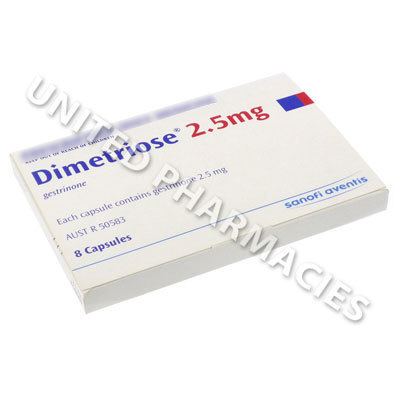Pregnancycategory X ATC code G03XA02 (WHO) Excretion Renal, fecal CAS ID 16320-04-0 | Routes ofadministration Oral, Intravaginal Metabolism Molar mass 308.41 g/mol | |
 | ||
AHFS/Drugs.com International Drug Names | ||
Gestrinone (INN, USAN, BAN) (brand names Dimetriose, Dimetrose, Nemestran), also known as ethylnorgestrienone (i.e., ethyl variant of norgestrienone), is a synthetic steroid of the 19-nortestosterone group that is marketed in Europe, Australia, and Latin America, though not in the United States, and is used primarily in the treatment of endometriosis. It is a potent mixed progestogen and antiprogestogen (i.e., partial agonist of the progesterone receptor (PR) or selective progesterone receptor modulator (SPRM)), an antigonadotropin, a mild androgen and anabolic steroid, and a functional antiestrogen. Gestrinone is described as similar in action and effect to danazol, which is also used in the treatment of endometriosis, but is reported to have fewer androgenic side effects in comparison. Because of its anabolic effects, the use of gestrinone in competition has been banned by the International Olympic Committee.
Contents
Medical uses
Gestrinone is approved for and used in the treatment of endometriosis.
Other uses
Gestrinone has also been investigated for use as a prospective contraceptive agent and as a postcoital contraceptive. It also has been used to shrink uterine fibroids and to reduce menorrhagia.
Contraindications
The drug is contraindicated in pregnancy, during lactation, and in patients with severe cardiac, renal or hepatic insufficiency. It is also contraindicated in patients who experienced metabolic and/or vascular disorders during previous estrogen or progestogen therapy, or who are allergic to the medication. The drug is contraindicated in children.
Side effects
Side effects of gestrinone include vaginal spotting, and, in susceptible individuals, signs of increased androgen activity such as acne, oily skin, fluid retention, weight gain, hirsutism, voice change, or hair loss.
Pharmacology
The mechanism of action of gestrinone is complex and multifaceted. The drug shows high affinity for the progesterone receptor (PR), as well as affinity for the androgen receptor (AR). Similarly to danazol, via activation of the PR and AR in the pituitary gland, gestrinone acts as a weak antigonadotropin and suppresses the midcycle surge of luteinizing hormone (LH) and follicle-stimulating hormone (FSH) during the menstrual cycle, without affecting basal levels of these hormones. It also inhibits ovarian steroidogenesis and, via activation of the AR in the liver, decreases concentrations of sex hormone-binding globulin, resulting in increased levels of free testosterone. In addition to the PR and AR, gestrinone has also been found to bind to the estrogen receptor (ER) with relatively avid affinity. Unlike danazol, gestrinone does not appear to bind to sex hormone-binding globulin or transcortin.
Metabolism
The drug is well absorbed via the oral route, passed through the liver, and has a half-life of about 24 hours. It is metabolized by the liver and excreted by urine and feces.
Chemistry
Gestrinone is an estrane (C18) steroid and is also known as 17α-ethynyl-18-methyl-19-nor-δ9,11-testosterone or as 17α-ethynyl-18-methylestra-4,9,11-trien-17β-ol-3-one (as well as 13β-ethyl-18,19-dinor-17α-pregna-4,9,11-trien-20-yn-17β-ol-3-one). It is a combined derivative of 17α-ethynyltestosterone (ethisterone) and 19-nortestosterone (nandrolone). As such, it is also a derivative of norethisterone (17α-ethynyl-19-nortestosterone). In addition, gestrinone is the 18-methylated derivative of norgestrienone (17α-ethynyl-19-nor-δ9,11-testosterone) and the δ9,11 derivative of norgestrel (17α-ethynyl-18-methyl-19-nortestosterone). Gestrinone is also known as ethylnorgestrienone due to the fact that it is the 18-ethyl variant of norgestrienone, which itself instead has an 18-methyl group.
The androgenic properties of gestrinone are more exploited in a designer steroid, its derivative tetrahydrogestrinone (THG), which is far more potent as both an androgen and progestogen in comparison to gestrinone. THG was banned by the Food and Drug Administration (FDA) in 2003.
